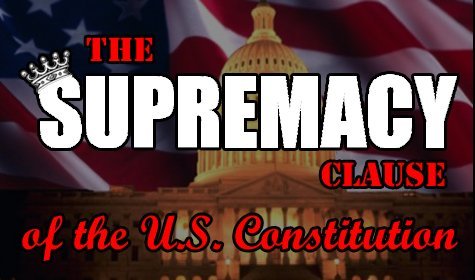The supremacy clause is one of the most misquoted, misunderstood and calculatedly falsely taught clauses of our Constitution. This clause has long been pointed to as the “trump card” of the federal government over the states. In fact, if you ask many people about which laws take precedent, the states or the federal governments, you will usually be met with the inane statement “Federal law always trumps state law”.
This is due to the fact that our modern law schools teach that the constitution means whatever the Supreme Court says that it means. Cases where the Supreme Court has decided that their interpretation of the Constitution is on the same level, and many times superior, to the people who constructed and ratified the Constitution. Cases like Altria Group v. Good (2008), Maryland v. Louisiana (1981) just to cite a few, have given rise to the legal theory of federal preemption (where federal law preempts state law should they come into conflict). The main problem with most cases of Constitutional interpretation is that we have allowed the Supreme Court to be the sole arbiter of what the Constitution means. We completely ignore any and all historical facts that could help us in the interpretation of its construction and subsequent ratification.
We have been foolishly taught that the Supreme Court is somehow isolated from politics, interest groups, and other governmental institutions and the judges themselves are somehow immune to personal whims, personal ideology, pressure from interest groups, and never have an eye toward building the court’s power. It is fancifully thought that the Supreme Court is the only true impartial arbiter in all cases dealing with Constitutionality.
So, what is the “Supremacy Clause”?
The Supremacy Clause can be found in Article VI, clause 2 of the US Constitution and states:
“This Constitution, and the Laws of the United States which shall be made in pursuance thereof; and all treaties made, or which shall be made, under the authority of the United States, shall be the supreme law of the land; and the judges in every state shall be bound thereby, anything in the constitution or laws of any state to the contrary notwithstanding.”
The part highlighted and underlined is the part of the clause that those who tout the “federal trumps state law” mantra seem to conveniently leave out.
But, there is an easier way to find out what the clause means. In cases of confusion, the place to go for answers is the state ratifying conventions. This is where the discussions were taking place as to whether our Constitution should even be ratified in the first place. The people scoured the Constitution to make sure that there were no loopholes that could be used to enslave the states. They painstakingly went over every clause of the Constitution to see EXACTLY what it was going to mean and bind the states by. So, let’s hear from the ratifying generation and what the Supremacy Clause was to be.
In the North Carolina Ratifying Convention, James Iredell explained that the supremacy clause meant only that:
“when Congress passes a law consistent with the Constitution, it is to be binding on the people.”
And he emphasized that
“the question, then, under this clause, will always be whether congress has exceeded its authority.” ~ Elliot, Jonathan. Debates in the Several State Conventions on the Adoption of the Federal Constitution (2d ed. Washington, D.C., 1836) Volume 4 page 179
William R. Davie, discussing the supremacy clause said that a federal law:
“can be supreme only in cases consistent with the powers specially granted and not in usurpations.” ~ Elliot, Jonathan. Debates in the Several State Conventions on the Adoption of the Federal Constitution (2d ed. Washington, D.C., 1836) Volume 4 page 182
In the Virginia Ratifying Convention, John Marshall assured the Ratifiers that the supremacy clause did not extend to all cases; that a federal law:
“not warranted by any of the enumerated powers’ would constitute “an infringement of the Constitution.” ~ Elliot, Jonathan. Debates in the Several State Conventions on the Adoption of the Federal Constitution (2d ed. Washington, D.C., 1836) Volume 3 page 553
In the New York Ratifying Convention, Antifederalist’s saw “the Supremacy Clause” and pointed to it with alarm. Alexander Hamilton assured them that each government [federal and state] was supreme in its sphere, stressing that:
“this balance between the National and State governments…is of The Utmost importance…It forms a double security to the people.” ~ Elliot, Jonathan. Debates in the Several State Conventions on the Adoption of the Federal Constitution (2d ed. Washington, D.C., 1836) Volume 2 page 257
In Federalist #33, Hamilton wrote that laws:
“which are not pursuant to its Constitutional powers, but which are invasions of the residuary authorities of the States”
will be merely
“acts of usurpation,” not “the supreme law of the land”.
Chief Justice McKean told the Pennsylvania Ratification Conventions that the meaning of the supremacy clause:
“is simply this, that the Congress have the power of making laws upon any subject over which the proposed plan gives them a jurisdiction, and that those laws thus made in pursuance of the Constitution, shall be binding upon the States.” ~ McMaster, J. B., and Stone, F., Pennsylvania and the Federal Constitution 1787-1788 (Lancaster, Pa., Inquirer Printing, 1888). Page 277
The state ratifying conventions do not show what the “federal trumps state law” supporters would have us believe it does. Instead, we find the understanding that Hamilton gave in the New York Ratification Convention. That each government is supreme within its own sphere of power. And that should congress create a law that is contrary to the Constitution, then it is no law at all, that they are merely ““acts of usurpation,” not “the supreme law of the land”.
Information for this article was gathered from the sources linked to in the article above as well as the book: Federalism: The Founders’ Design by Raoul Berger

